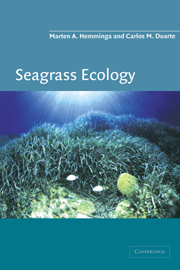5 - Elemental dynamics in seagrass systems
Published online by Cambridge University Press: 29 September 2009
Summary
Introduction
In the previous chapter we discussed the ways seagrasses obtained carbon, nitrogen and phosphorus from the environment, elements that are vital for their structure and functioning. As tissues die, these elements are again lost from the plants, although resorption processes may somewhat mitigate the loss rates. The plants thus have a direct influence on the dynamics of chemical elements in their environment. Uptake by, and loss of, elements from the living plants are only two aspects of the fluxes of matter in seagrass systems. In this chapter we will focus on the various processes determining these fluxes, with particular attention to those relevant to the dynamics of carbon, nitrogen and phosphorus. A variety of processes, biological, physical and chemical, plays a role in shaping the dynamics of these elements, but they share one feature in common: directly or indirectly they are influenced or even determined by the presence of the key species in the system, the seagrasses. Primary production and mineralization are two major processes driving the carbon and nutrient dynamics within the seagrass system, these processes coinciding with fixation and release of inorganic compounds, respectively. Inorganic nitrogen- and phosphorus-containing compounds released during mineralization can be captured again for the production of plant biomass. Although much of the plant biomass dies without being eaten by herbivores and is directly processed by the decomposer community, some of it is consumed by herbivores.
- Type
- Chapter
- Information
- Seagrass Ecology , pp. 146 - 198Publisher: Cambridge University PressPrint publication year: 2000
- 1
- Cited by



